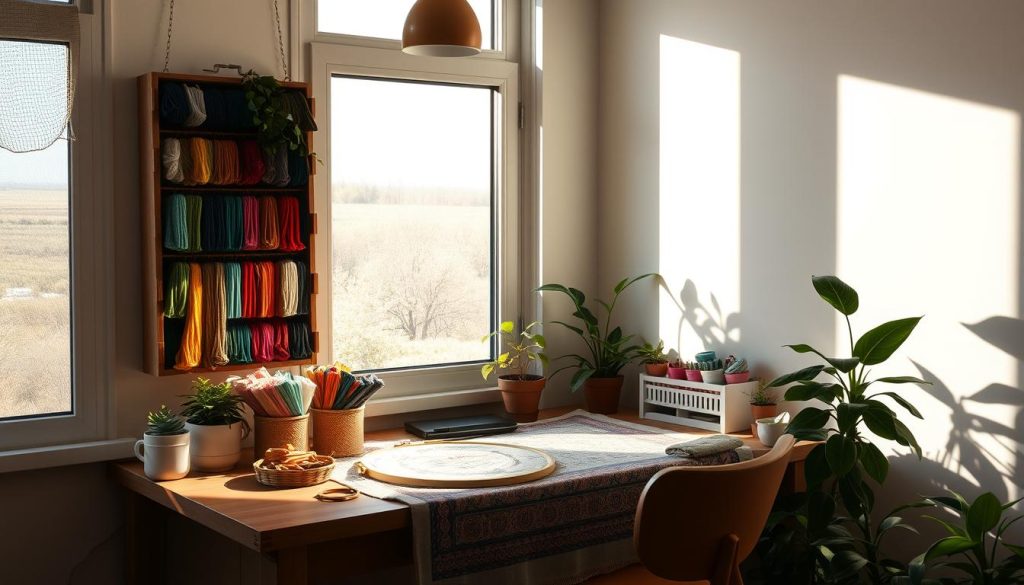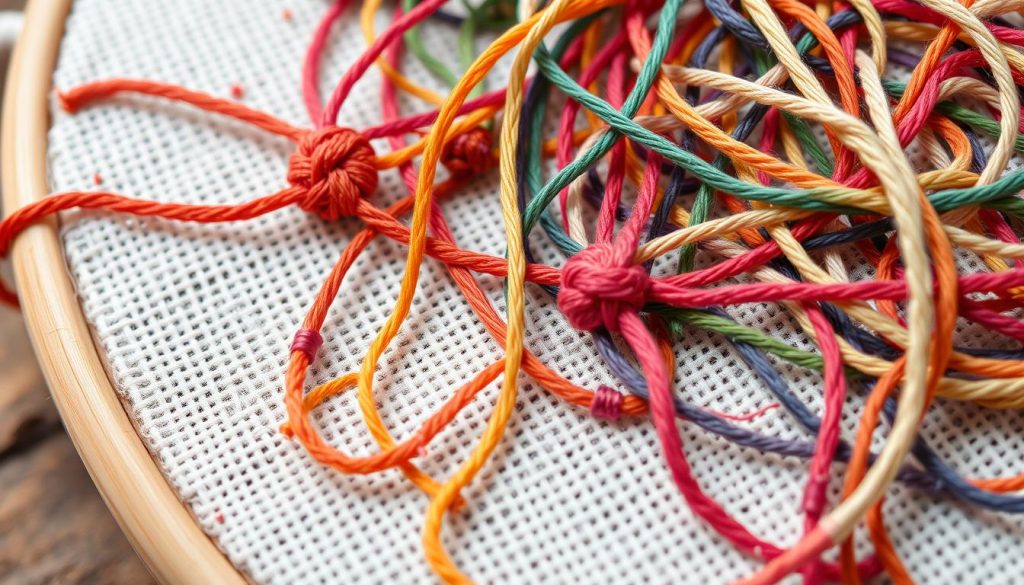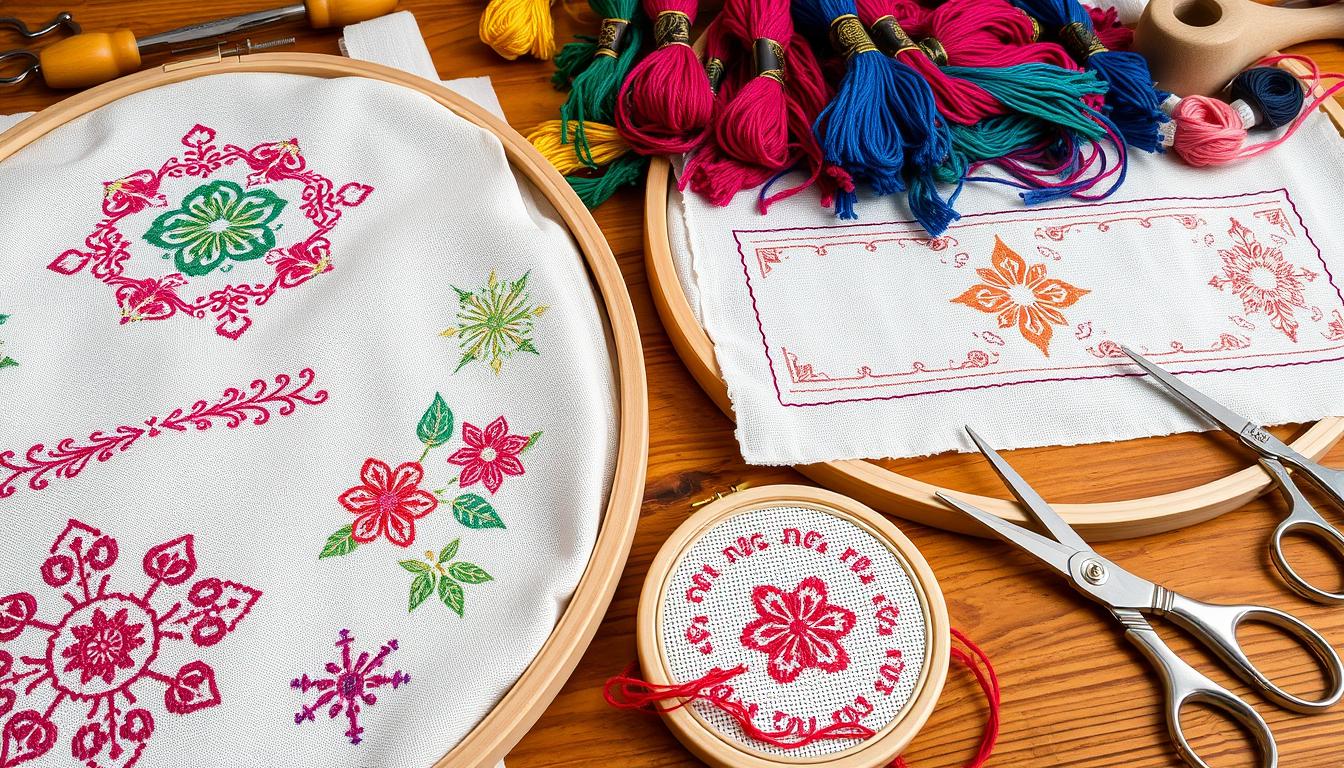Learning cross stitch can be both fun and tough, especially for newbies. Cross stitch fans often face many hurdles that can mess up their work. From picking the right stuff to keeping stitches even, knowing how to dodge these traps is key for a top-notch finish. This guide shares great tips and tricks to steer clear of common mistakes and make your crafting better.
Cross stitch needs careful attention and patience. Spotting and fixing mistakes early can save you a lot of trouble. By mastering the basics and knowing common issues, you can make sure your cross stitch projects are amazing.
Key Takeaways
- The right fabric count is key for your project’s size and look.
- Gridding the fabric before stitching helps you stick to the pattern.
- Stitching in one direction makes your cross stitch look even.
- Using two strands of thread keeps your work neat and tidy.
- Avoid knots at the back to prevent a messy look.
Choosing the Correct Fabric Count
Understanding fabric count is key for great cross stitch projects. We’ll explore why fabric count matters, how to measure it, and why Aida cloth is great for newbies.
Understanding Fabric Count
Fabric count shows how many threads or squares are in one inch of fabric. Higher counts, like 18 or 22, mean smaller squares for detailed designs. Beginners often start with 14 count Aida cloth, which is easy to use.
Knowing your fabric count helps you pick the right size and look for your cross stitch.
Using a Ruler or Gauge Tool
Getting the fabric count right is crucial. You can use a ruler or a gauge tool for this. Place the tool on your fabric and count the threads in one inch to find the count.
This makes sure your fabric fits your pattern perfectly.
Benefits of Aida Cloth for Beginners
Aida cloth is perfect for beginners because of its clear grid. It makes it easy to place stitches right, cutting down on mistakes. It comes in counts from 6 for big projects to 22 for detailed ones.
As you get better, you can move to higher counts like 16 or 18. Most stitches on Aida use two threads, but higher counts might need just one for a finer look.
| Fabric Type | Common Counts | Suitable For |
|---|---|---|
| Aida Cloth | 6, 11, 14, 16, 18, 20, 22 | Beginners, All Skill Levels |
| Fiddler’s Cloth | 14, 16, 18 | Intermediate to Advanced |
| Evenweave | 25, 28, 32 | Advanced |
| Linen | 28, 32, up to 50 | Experts |
Choosing the right fabric count and using the right tools can greatly improve your cross stitch. With Aida cloth, beginners can start their journey with confidence and ease.
The Importance of Proper Lighting
Good lighting is key for cross stitch to improve both precision and comfort. The right cross stitch lighting can greatly enhance your project’s quality and enjoyment. Let’s look at different lighting options to boost your stitching experience.
Dedicated Stitching Lights
Dedicated stitching lights like the 70W BlueMax dimmable floor lamps offer full spectrum light. This reduces color distortion and provides bright task lighting without pulsation. The Stella Two desk lamp offers triple-range LED lighting, combining warm, cool, and natural light. It’s a versatile and portable choice for cross-stitch lovers.
It’s crucial to pick lights with adjustable settings. This way, you can adjust the brightness to your liking and reduce eye strain.

Clip-On and Tabletop Lighting Options
Clip-on lights and tabletop options are great for flexibility. Mighty Bright clip-on lights are perfect for traveling, reading, and needlework in tight spaces. They provide enough light right where you need it.
The Ott lights are budget-friendly but might not be bright enough for detailed tasks. They may also pulsate, causing discomfort over time.
Using Magnifiers for Higher Stitch Counts
Magnifiers are vital for higher stitch counts in your cross stitch tools. The Dublin Craft Magnifier combines lighting and magnification for long-lasting precision and comfort. For customized magnification, CraftOptics offers high-end solutions that fit your needs and prescription glasses.
Using these magnifiers can greatly improve your stitching accuracy. It ensures you don’t miss any details in your complex patterns.
Maintaining Consistent Tension
Keeping cross stitch tension even is crucial for professional-looking results. It’s important to master different cross stitch techniques for a smooth look.
Using a Hoop or Frame
Using a cross stitch hoop or frame helps keep tension even. These tools keep your fabric tight, preventing loose stitches. The Q-Snap is a favorite for its taut stitching area and even tension.
Evenweave fabric is also recommended. It’s pliable, making it easier for tools to keep tension consistent. A cross stitch hoop or frame keeps your fabric tight, preventing uneven tension.
Crossing Stitches in the Same Direction
Crossing stitches in the same direction is key. The Danish method is especially good with DMC or solid threads. It makes your top stitches neat and uniform.
Stitches going in the same direction prevent irregularities. This is important because uneven stitches can ruin the look of your canvas.
Avoiding Overly Tight or Loose Stitches
It’s important to avoid tight or loose stitches. Start with a short thread length, like 12”, and increase it as needed. Hooking your little finger around the floss helps avoid over-tightening.
Techniques like railroading can also help. They prevent twisted stitches, making your work look better.
Practicing different techniques is key. Use the right hoop or frame, cross stitches the same way, and avoid tight stitches. Remember, the more you practice, the better you’ll get!
Avoiding Thread Knots
Keeping your stitching smooth and enjoyable is key. Good thread management makes your work look clean and beautiful. Here are some cross stitch tips to avoid common threading problems.
Managing Thread Length
It’s important to keep your thread at the right length. Aim for about 18 inches to avoid tangling and fraying. For most patterns, using two strands of thread is best. Storing your thread on bobbins and in thread organizer boxes helps prevent tangles.
| Thread Management Tips | Description |
|---|---|
| Thread Length | Keep around 18-24 inches to minimize tangling. |
| Strand Separation | Pull out each thread one at a time to prevent tangles. |
| Thread Storage | Use bobbins and thread organizer boxes for better management. |
Using Thread Conditioner
Thread conditioner like Thread Magic can help a lot. It prevents snagging and twisting, making stitching easier. You can also make your own conditioner with a DIY YouTube tutorial that lasts about 4-5 minutes.

Letting Needle Dangle to Prevent Twisting
Letting the needle dangle is another good trick. Hold up your project every seven or eight stitches. This lets the thread untwist naturally, preventing knots. Pulling the thread from the bottom of a DMC skein also helps reduce tangling.
Ensuring Accurate Cross Stitch Patterns
Getting your cross stitch right is key to a great project. To stitch accurately, use counting techniques and gridding. Counting right stops mistakes like wrong colors or stitches.
Gridding helps too. It’s making a grid on your fabric that matches your chart. This keeps your stitches in line and makes complex patterns easier.
Pattern markers are also useful. They mark important parts of your chart. With counting and gridding, markers help you stitch accurately.
For the best results, follow these steps:
- Choose clear, easy-to-read cross stitch charts.
- Start stitching from the center to keep things straight.
- Use an embroidery hoop to keep your stitches even.
- Always cross your stitches in the same direction.
- Use gridding for big or complex patterns.
- Stick to one or two strands of embroidery floss for best results.
By using these tips, your cross stitch will be precise and beautiful. Happy stitching!
Conclusion
To succeed in cross stitch, you need to be careful and detailed. Choosing the right fabric and keeping your stitches even are key. These steps make your work look better and more fun.
Even experienced stitchers sometimes make mistakes. But these mistakes can teach you a lot. For example, a wrong stitch can change the look of your project.
The cross stitch world has many materials for different budgets. You can find everything from affordable Aida fabric to more expensive hand-dyed linen. Joining cross stitch groups and entering competitions can also help. It brings you closer to others who love this hobby.
